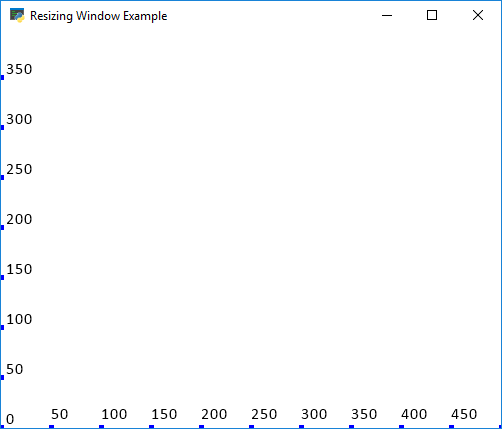Resizable Window#

resizable_window.py#
1 2 3 4 5 6 7 8 9 10 11 12 13 14 15 16 17 18 19 20 21 22 23 24 25 26 27 28 29 30 31 32 33 34 35 36 37 38 39 40 41 42 43 44 45 46 47 48 49 50 51 52 53 54 55 56 57 58 59 60 61 62 63 64 65 66 67 | """
Example showing how handle screen resizing.
If Python and Arcade are installed, this example can be run from the command line with:
python -m arcade.examples.resizable_window
"""
import arcade
SCREEN_WIDTH = 500
SCREEN_HEIGHT = 500
SCREEN_TITLE = "Resizing Window Example"
START = 0
END = 2000
STEP = 50
class MyGame(arcade.Window):
"""
Main application class.
"""
def __init__(self, width, height, title):
super().__init__(width, height, title, resizable=True)
arcade.set_background_color(arcade.color.WHITE)
def on_resize(self, width, height):
""" This method is automatically called when the window is resized. """
# Call the parent. Failing to do this will mess up the coordinates,
# and default to 0,0 at the center and the edges being -1 to 1.
super().on_resize(width, height)
print(f"Window resized to: {width}, {height}")
def on_draw(self):
""" Render the screen. """
self.clear()
# Draw the y labels
i = 0
for y in range(START, END, STEP):
arcade.draw_point(0, y, arcade.color.BLUE, 5)
arcade.draw_text(f"{y}",
5, y,
arcade.color.BLACK,
12,
anchor_x="left", anchor_y="bottom")
i += 1
# Draw the x labels.
i = 1
for x in range(START + STEP, END, STEP):
arcade.draw_point(x, 0, arcade.color.BLUE, 5)
arcade.draw_text(f"{x}", x, 5, arcade.color.BLACK, 12,
anchor_x="left", anchor_y="bottom")
i += 1
def main():
MyGame(SCREEN_WIDTH, SCREEN_HEIGHT, SCREEN_TITLE)
arcade.run()
if __name__ == "__main__":
main()
|